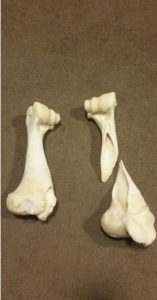We have all heard the disaster stories of farms having up to 30%, and higher in some cases, of their heifers becoming acutely lame in a forelimb, resulting in them having to be euthanised. Often these are well- grown healthy heifers just walking around in the paddock. A “gunshot” noise can be heard, and the heifer goes lame. This lameness is caused by sudden fracturing of the humerus. It is an acutely painful break, the bone not so much cracking as shattering with an incredible amount of soft tissue damage. These animals must be euthanised immediately for welfare reasons. These breaks tend to happen around the point of calving and can be absolutely devastating.
So, what is the cause? Unfortunately, this is a tricky question. And the answer appears to be multifactorial. It is currently being researched, but the following are identified risk factors in the first two years of life:
Any of the above can lead to a thinning of the cortex (the outside hard part) of the humerus bone. When a heifer gets to the point of calving, she mobilises bone to supply calcium for lactation. If the bone cortex is too thin, she can end up with a broken leg, even without any undue stress upon it.
One of the big questions that clients ask is, does fodder beet cause broken legs in heifers? The answer is, as we understand it, not directly. There is however an association. Feeding beet can be a cause of the bone disease called rickets. It causes the bone formed to be poorly mineralised and weaker than normal. Rickets is the result of either vitamin D or phosphorous (P) deficiency. We know that beet is deficient in P (among other deficiencies), which seems to be the most likely cause. The other issue with beet is that you get a large amount of soil ingestion which compromises copper (Cu) absorption and causes levels to drop. So, with feeding beet we increase the risk of both low P and Cu – this can lead to the perfect storm for broken legs. That is not to say broken legs cannot happen on other crops. There are plenty of examples of farms that have had outbreaks of humeral fractures and the heifers have not touched a single fodder beet bulb in their lives.
So, how do you ensure you do not end up with broken legs in your heifers? There is no one thing, being a multifactorial condition. The best you can do is to avoid ending up with one of the aforementioned risk factors occurring in the first two years of life. Talk to your vet about the feeding plan and management of your growing youngstock. Setting up an animal health plan is a very valuable tool to ensure intervention and monitoring is consistent and timely. With regard to fractures, especially ensure you are adequately supplementing phosphorous (if needed) and copper. Copper monitoring should be carried out regularly on your youngstock – this can be by bloods, but it is best to take liver biopsies. These give us a much better idea of storage levels which is especially useful pre-winter.
Shannon Thompson-Laing
Vetlife Ashburton
